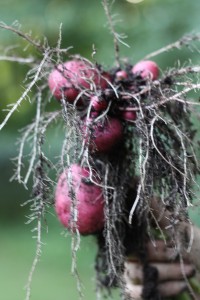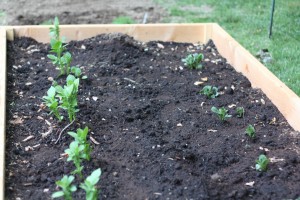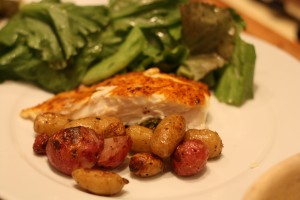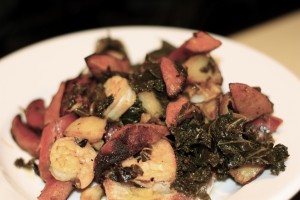“Honey–?
“Hi sweetie, what’s up?”
“She brought us seed potatoes–”
“Potatoes?”
“Potatoes. Heirloom seed potatoes from Iowa, that she schlepped all the way from New Mexico.”
And that’s the thing—When Deborah Madison carries seed potatoes all the way from New Mexico and presents them to you at lunch in Manhattan, you plant them. For a whole variety of reasons.
“You’re growing potatoes?” Susan’s mother asked us, bewildered.
“We are—”
“Why?”
“Because they’re special potatoes.”
“Why?”
It was like having a conversation about the birds and the bees with a seven year old.
We explained the whole seed saver-heirloom variety thing, and the Deborah Madison thing, and then we hung up and went outside to start digging our bed in the only remaining spot on our property that gets sun; we had no luck because the ground in New England is made of granite. We stared at the little shopping bag that had traveled great distances, and went out to Lowe’s to buy some untreated lumber for the new raised beds we were going to have to build. The only place left to put two more garden boxes was in the front yard, which, in our part of Connecticut, generally gets weird looks.
When we got home, our neighbor Kitty from across the street wandered over.
“What are you doing?”
We were sitting on the ground with the drill, attaching the long boards to the short boards. I looked up at her.
“Planting potatoes–”
“Why?” she asked.
“For the goats—-” I answered, squinting.
She turned around and went back home.
A few hours later, we had two gigantic, 10 x 4 foot boxes near our front driveway, and the next day, we were on our hands and knees again, planting two types of heirloom seed potatoes brought to us by the woman who basically invented modern vegetarian cuisine in America.
“You know,” my mother said, “you can buy potatoes in this country.”
But my mother doesn’t get the idea of vegetable gardening anyway. She once declared that non-organic food was inherently “cleaner” than the organic stuff, which she learned on a television news show was grown in shit.
“Watching Glenn Beck again, mom?” There was no hope for her.
Anyway, about ten days after we planted the potatoes, we had spectacular potato plants; a week or so after that, they were nearly as tall as I am (which isn’t saying much, but still).
And when we finally had new potatoes that were ready for immediate eating, they were honest-to-god spectacular. The La Rattes–tiny, creamy, sweet orbs that are delicate and velvety–were remarkable; the All-Reds (also known as Cranberry Reds)–bright pink, stronger tasting, and very low in starch–were nutty and completely lacking in that cottony texture that store-bought potatoes often have. Together, they changed the way I think of mass-produced, grocery store potatoes in general: pasty, dusty, and without much flavor unless you drench them in olive oil, herbs, and butter, which is totally unnecessary.
We recently pulled up our end of summer vegetables, and there’s no question that of all the things we grew (except for tomatoes, which were excellent this year), the potatoes took the prize; the tatsoi was leathery, the Bright Lights chard nearly flavorless, the Dragon Tongue beans very late, the cucumbers pathetic, and the zucchini non-existant. All told, our spud yield was about ten pounds, so right now we’re planning on constructing some sort of box that will sit in the basement and allow us to have them through the Fall without threat of their being nibbled on by the tiny critters who sometimes squeeze themselves underneath the garage door, looking for warmth during the last bitter days of autumn.
Naturally, though, our spectacular potato harvest also coincided with my learning that my familial Triglycerides are through-the-roof, and that my carbohydrate consumption needs to be seriously minimal. “Lay off the pasta,” the doctor said.
“What about potatoes?” I asked.
“You’re kidding, right?” she said.
“No. We grew them.”
“You grew potatoes? Why?”
And I started my whole song and dance—why we grew them, how much more delicious they were, how easy they were to grow, and the fact that just because we grew them didn’t mean that we were having mashed potatoes every night of the week. We’d do things like offset their carbs with copious quantities of protein—namely shrimp, fish, chorizo, and kale. (Of course, we’d also just steam and toss them with fresh chopped parsley and a pinch of sea salt. That’s the part I left out.)
She looked at me with a gimlet eye.
Triglycerides be damned, next year we’ll be growing them again. And even if I eat two at a time, they will be well worth it.
Portuguese-style Potatoes with Kale, Shrimp, and Chorizo
Admittedly, this is a robust, cooler-weather dish. But if you’re using potatoes and kale from your garden, the flavors will be far less sharp, and much more refined than they are when you make it in the dead of winter. Fold the leftovers into a frittata the next day, and enjoy a perfect room-temperature dinner with a glass of cold Albarino.
Serves 4 or 2 with leftovers
1 teaspoon extra virgin olive oil
2 links smoked chorizo, or one 6-8 inch length fresh chorzio, sliced into 1″ rounds
1/2 teaspoon pimenton dulce
1/2 cup diced onion
3/4 pound La Ratte potatoes, halved
1/4 cup water
1 medium bunch Lacinato kale, washed and roughly chopped
1/2 cup dry white wine
1/2 pound large shrimp, cleaned and peeled
1. In a medium, fire-proof earthenware dish (such as a cazuela, or similar casserole), warm the olive oil over medium heat until it shimmers. Add the chorizo, and cook for about eight minutes, stirring frequently, until it just begins to brown around the edges and releases its fat into the pan. Using a slotted spoon, remove it to a plate lined with a paper towel, and set aside.
2. Sprinkle the pimenton into the dish and stir well, until it is incorporated into the oil in the pan. Add the onions and cook slowly until translucent, about six to eight minutes, stirring every few minutes to keep it from sticking. Fold the potatoes in with the onions, add the water, stir, and cover for about seven minutes, until the potatoes begin to soften.
3. Return the chorizo to the pan, toss well, and add the kale. Stir briskly until the warm onion, potatoes, and sausage begin to weigh down the greens, and they start to wilt. Pour in the wine and add the shrimp, raise the heat to medium high, stir well, and continue to cook until the greens are completely softened, the shrimp are cooked through, and the potatoes are tender, about another six minutes.
Serve hot, or at room temperature on slices of grilled and garlic-rubbed whole-grain bread.








Wonderful, and as hard as it is to do, be sure to set some aside for seed for next season.
Great piece! And isn’t it a little sad that far too many people haven’t had a chance to taste homegrown potatoes??
Here are a couple of thoughts that can be shared (gently) with receptive folks who question the “why bother?” aspect. 1. Almost all industrial potatoes are genetically enginered. I have concerns about the world politics and maga-biz involved in engineered crops. 2. Before being mechanically harvested, big potato fields are sprayed with herbicide to kill the potato foliage. Since the tuber (the part we eat) is the “storehouse” for the plant, I wonder how much herbicide ends up in there. 3. Whenever I have shared some homegrown food, it has knocked people’s socks off. In my experience, passing along the bounty (even one or two potatoes) can often create the next gardener. Sigghhh, but it is really hard to share sometimes….
Enjoy! Later, Tater! kw
Thanks so much for the wonderful response Katherine!
Great read and for a die hard potato lover, this piece got my carbohydrate juices flowing. A toast to the potato…..a much underrated veggie……
may you continue to thrive even under pressure from the nay sayers.
I was wondering if you guys had enough sunlight for those two beds.
Apparently, yep. Alicia and I have also enjoyed organic, heirloom spuds
this summer from a local grower. They are worth every drop of gasoline
to seek them out. Next year try the Fingerling varieties, if you have extra
I know someone who can take them off your hands.
P.S. nice wine choice
Great post. Somehow I just can’t bring myself to agree with your doctor that a homegrown, organic, potato is comparably awful for your health as a store bought-mass-produced-grown with pesticide farmed wheat-and shipped for days if not weeks on end all the while wrapped in plastic-loaf of bread. I say enjoy your homegrown veggies of all sizes, shapes and colors!
We’d love for you to share this story with our members at YourGardenShow.com if you are so inclined. I know they would appreciate your story and photos!
Thank you.
I wish I had the patience. This sounds wonderful. I love the way you write. I have yet to taste your cooking, but feel I almost can.
Jeff, we have to change that—-thank you. We’ll figure out a time in the Fall for you guys to come to dinner. Would love to see you!
Loved your article!
A few years ago, I planted some potatoes that had been in the cupboard for too long and had “eyed”–just threw them into the ground with no fertilizer or fuss. Two or three weeks later, we had delicious fingerlings that tasted snappy with very little seasoning. Maybe I should plant all the potatoes I buy!